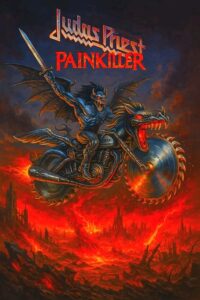
You’ve uploaded the iconic cover art for Judas Priest’s Painkiller — one of the most legendary heavy metal albums ever released.
Here’s a breakdown of what makes this artwork (and the album) so metal:🔥 Visual ElementsThe Painkiller character: A winged, muscular, demonic cyborg riding a metallic dragon-motorcycle with buzz saw wheels. He wields a sword and screams through a hellish sky.The background: A vivid apocalyptic landscape filled with lava rivers, firestorms, and destruction.Logo: The classic, razor-sharp Judas Priest font and blood-red Painkiller title above it, emphasizing intensity and power.🎵 About the Album (Painkiller, 1990)Band: Judas PriestGenre: Heavy Metal / Speed MetalNotable tracks:”Painkiller” (insane drumming, shredding solos, and Rob Halford’s god-tier vocals)”Hell Patrol””A Touch of Evil”Drummer debut: Scott Travis, whose double-kick intro on the title track redefined metal drumming. LegacyPainkiller is widely considered one of the greatest heavy metal albums ever — a return to form and then some.This artwork, created by Mark Wilkinson, became instantly iconic — a visual as powerful and over-the-top as the music itself.

Absolutely — here’s a 900-word tribute to Judas Priest’s iconic Painkiller album, capturing its legacy, sonic power, and cultural impact:
Jdas Priest’s Painkiller: The Thunderous Resurrection of Heavy Metal
Released in 1990, Painkiller wasn’t just another album—it was a seismic event. It marked a rebirth for Judas Priest and a redefining moment for heavy metal as a genre. At a time when metal was being challenged by grunge and alternative rock, Priest roared back with an album so ferocious, so blisteringly fast, and so unapologetically intense, it reminded the world exactly what heavy metal was meant to be: loud, fast, mythic, and dangerous.
From the opening thunderclap of drums to the final shriek of Rob Halford’s soaring vocals, Painkiller is an adrenaline-drenched ride through fire, steel, and fury. It is metal in its purest form—unfiltered and uncompromising.
At the heart of the album lies the title track, “Painkiller”—a song that is nothing short of a masterclass in speed, power, and precision. Scott Travis, the band’s new drummer at the time, opens the track with a legendary double-kick assault that feels like a machine-gun rolling down the apocalypse. It’s relentless, mechanized thunder that punches through the speakers like a war cry from the gods.
And then Halford enters. His voice is not human—on this record, he’s something more. Something elemental. Screaming like a banshee sent from Valhalla, Halford’s vocals on Painkiller are among the most revered in metal history. He reaches notes few can even dream of, delivering every line with surgical sharpness and theatrical flair. “Faster than a laser bullet / Louder than an atom bomb”—those lyrics aren’t just describing the Painkiller; they describe the album itself.
The music is equally monstrous. Glenn Tipton and K.K. Downing, the twin guitar wizards of Judas Priest, deliver riff after riff that sound like they were forged in the depths of some cybernetic hellscape. Their solos on “Painkiller,” “Metal Meltdown,” and “All Guns Blazing” are feral, melodic, and virtuosic—wailing cries of chaos and catharsis. Bassist Ian Hill, the quiet engine behind the band, keeps the foundation pounding with relentless rhythm, anchoring the madness with ominous weight.
But Painkiller is not just about speed or technicality—it’s about scale. Every track is delivered with the grandiosity of myth. These aren’t songs; they’re metal epics. “Hell Patrol” rides in like a futuristic death squadron. “Night Crawler” feels like a horror film turned into a headbanger’s hymn. “A Touch of Evil” creeps with seductive darkness, showcasing Priest’s ability to summon atmosphere as well as aggression.
Lyrically, the album is drenched in science fiction, apocalyptic imagery, and anti-hero legends. The Painkiller himself—a metallic angel of vengeance—flies in from the skies on a dragon-motorcycle with buzzsaw wheels, cleansing the world with divine fury. It’s campy, yes, but in the best way. Priest never shied away from the theatrical. They embraced it. They made it part of metal’s DNA.
And then there’s the cover art.
Designed by Mark Wilkinson, the Painkiller album cover is a masterpiece of metal imagery. A winged cyborg demon rides a monstrous steed forged from chrome and fire, set against a volcanic backdrop of destruction. The buzzsaw wheels, the glowing red sky, the snarling chrome dragon—it’s everything an album like Painkiller needed: a visual as absurdly powerful as the music itself.
Painkiller was also a triumphant return after some turbulent years for the band. Judas Priest had experimented with different sounds throughout the ’80s, to varying degrees of success. While they had delivered classics like Screaming for Vengeance and Defenders of the Faith, later releases were met with mixed reactions. But with Painkiller, Priest didn’t just bounce back—they obliterated every doubt. They proved they could evolve, adapt, and still remain the high priests of metal.

For many fans, Painkiller remains the gold standard of heavy metal. It’s an album that demands full volume, that ignites mosh pits, and that has inspired generations of metal musicians across the globe. From power metal to thrash, death to progressive, the album’s fingerprints are everywhere. It bridged the classic and the modern, honoring the roots of metal while pushing its boundaries into something more aggressive, more extreme.
Rob Halford would soon depart the band after this album (returning triumphantly years later), but Painkiller stands as his vocal magnum opus. His performance here is untouchable—an untamed mix of operatic power and raw aggression. It cemented his status as one of the greatest vocalists in the history of rock and metal.
Even decades later, Painkiller has lost none of its potency. It’s still a favorite among fans, still a staple in metal playlists, still shouted in bars and venues and festivals from Tokyo to São Paulo. When that drum intro kicks in, every true metalhead knows exactly what’s coming.
Painkiller is not just an album—it’s a war cry, a gauntlet, a prophecy screamed through a flaming megaphone. It’s the sound of metal unchained, reborn in fire, and riding a dragon through the end of the world
And it still kills. Every. Single. Time.
If you’d like, I can also create a story or fantasy narrative inspired by the Painkiller character himself — a tale of veng
eance, fire, and metal. Want that next?



